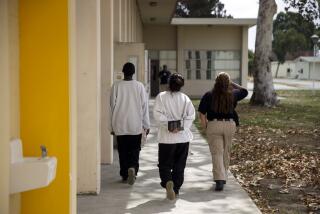L.A. County supervisors vote to ban pepper spray in some Juvenile Hall units

Nearly four years ago, Los Angeles County supervisors voted to stop probation officers from using pepper spray at juvenile facilities, likening its use to an âassaultâ â only to see the ban go unheeded.
Clearly angered by the continued and expanding use of pepper spray, which can cause eyes to tear and redden and skin to burn and blister, the Board of Supervisors on Tuesday unanimously approved another ban â though it more narrowly targets only certain sections of Central Juvenile Hall.
Tuesdayâs motion, crafted by Supervisor Hilda Solis, gives the Los Angeles County Probation Department 45 days to stop using pepper spray in units within Central Juvenile Hall that house some of the most marginalized young people. The vote was met with opposition from a coalition of probation unions, who say they need the chemical as a last resort to break up violent fights without physical intervention.
The board first voted in early 2019 to ban all juvenile detention facilities from deploying pepper spray, also known as oleoresin capsicum or OC spray.
California is one of a handful of states that allow probation officers in youth facilities to use pepper spray. The L.A. supervisors gave the department until the end of 2019 to join most of the U.S. in barring it.
But the Probation Department said it needed more time, more de-escalation training and more staff to safely transition away from using pepper spray. The COVID-19 pandemic delayed matters further.
Almost four years later, the politicians and youth advocates who cheered the ban say it has clearly failed.
All five supervisors grilled Chief Probation Officer Adolfo Gonzales on why the 2019 ban had not been enforced. Solis said she was âsaddened,â Supervisor Holly Mitchell called the lack of movement âfrustrating,â and Supervisor Lindsey Horvath, who co-authored the motion, called it âunacceptable.â
âI think everyoneâs really upset. I think everyoneâs being really polite, chief,â said Board Chair Janice Hahn. âCome on, chief! This is important to this board. ⦠We just are not in the mood to have any more excuses.â
Rather than see a decline, county leaders have watched the use of the controversial chemical become increasingly common.
At Central Juvenile Hall in Lincoln Heights, one of the countyâs two juvenile detention facilities, officers used pepper spray 157 times between June and September, according to a recent report by the Probation Oversight Commission, a civilian watchdog body.
Officers inside the Barry J. Nidorf Juvenile Hall in Sylmar used pepper spray about 75 times despite incarcerating a larger population throughout those four months.
The countyâs juvenile camps, which operate separately from the two juvenile halls, no longer use the spray.
Two weeks ago, an independent watchdog told the Los Angeles County Board of Supervisors that it should consider banning pepper spray at juvenile detention facilities, citing examples of the inappropriate and avoidable use of the spray by officers.
The oversight report found that some units within Central were disproportionately sprayed: those that house girls and youth with developmental disabilities.
Startled by the spike, the board set a new deadline for the Probation Department to phase out the spray in units incarcerating juveniles with developmental disabilities, girls and gender expansive youth, a term used to describe those who donât conform to traditional gender identities.
The report also noted that the probation department during the pandemic had stopped training on how to serve people with developmental disabilities and never resumed it.
Gonzales struck a conciliatory tone Tuesday as he said he too would like to see OC spray eliminated and thought it would be when he took the helm of the troubled department in February 2021. He agreed that the department needed better trained staff and wanted to see juvenile halls become a âprofessional organization.â
âYou know, most of our [detention services officers] that come in are people that come off the streets,â he said. âMaybe we need someone with a higher level of experience coming in.â
If the training on serving people with developmental disabilities was indeed suspended, he said, he wanted to find out why. This statement, indicating that he was not aware that the training had stopped, drew a sharp rebuke from the board.
âI would put your training unit on notice that this motion is a direct result of their failure to do their job,â said Supervisor Kathryn Barger.
The probation department has until Feb. 3, 2023, to stop using the spray in certain units.
âWe mean business,â Solis, whose district includes Central Juvenile Hall, said in an interview. âThatâs what this motion is about.â
The motion is meeting opposition from a coalition of unions representing employees inside the Probation Department. AFSCME Local 685, SEIU Local 721 and AFSCME Local 1967 decried county leadersâ latest attempt to ban the spray as dangerous and half-baked.
Officers say they use the spray as a last resort to break up violent fights. Without the chemical, the union leaders said, officers would have to physically intervene, which they said would be more dangerous for all involved.
âWith this motion, the only option the Board of Supervisors would leave is for us to use hands-on force,â Probation Manager Deborah Lares, president of the Professional Managers Assn., said in a statement. âIt is simply irresponsible for anyone to assume that every situation inside the juvenile halls and camps can be resolved with a conversation and that every officer is physically capable of stopping a violent attack.â
Get the lowdown on L.A. politics
Sign up for our L.A. City Hall newsletter to get weekly insights, scoops and analysis.
You may occasionally receive promotional content from the Los Angeles Times.
The push by the county comes as the departmentâs staffing crisis reaches new extremes.
The Times reported in November that dozens of officers were refusing to show up for work, saying they felt outnumbered and threatened on the job. As the staff shrank, officers were using force on young people more often. The number of times youth were pepper-sprayed quadrupled in the first half of 2022 compared with the first half of 2021.
Itâs not clear how the board will enforce the ban now on the department, which has said it would like to see a youth-to-staff ratio of 5-to-1 before phasing out the spray. The current ratio is 8-1, according to a department spokesperson.
Should the probation department fail to meet the 45-day deadline, Solis said, the board would âcome back and ask the question why.â
Some youth advocates, like Mili Kakani, the director of youth justice with the Childrenâs Defense Fund in California, say theyâre skeptical this motion will bring real change.
âWe know that the union has made every effort to essentially ignore this direction and maintain its use of OC spray,â she said. âSo itâs a struggle to see whatâs going to be different this time.â
Wende Julien, executive director of the Probation Oversight Commission, said she sees a few reasons to believe the motion will have an impact. She said the relatively low reports of pepper spray usage at Barry J. Nidorf Juvenile Hall were encouraging. The department has not been issuing OC spray to new recruits, she added.
âIt can be done,â she said in an email. âMany probation staff have demonstrated they have the necessary skills to deescalate incidents without OC spray.â
More to Read
Sign up for Essential California
The most important California stories and recommendations in your inbox every morning.
You may occasionally receive promotional content from the Los Angeles Times.











